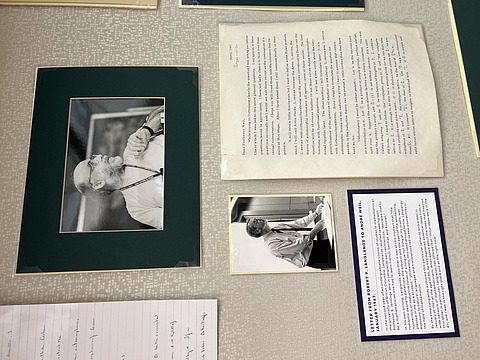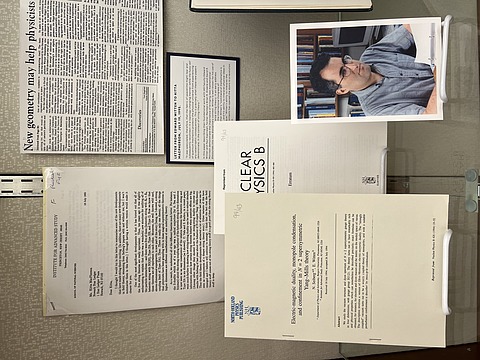New exhibition explores translation, transformation, and remediation in mathematical discourse
Scholars at the Institute for Advanced Study often find themselves at intersections: of disciplines, of method, of format, of culture, and often of language itself. This might appear most obvious in the Schools of Historical Studies and Social Science, which explore topics of broad temporal and geographical scope, and function in multiple languages. Meanwhile, their companion Schools across campus work in what has been described as a single, true, “universal language”: mathematics.
A new exhibit, co-curated by the Mathematics – Natural Sciences Library and the Shelby White and Leon Levy Archives Center, takes a critical look at this notion. The displays, spread across both spaces, probe what it takes to construct meaning in mathematical language; explore how IAS scholars have constructed and circulated advances in mathematical concepts; illustrate the impact of networks of remediation within mathematical culture; and expose the invisible labor that keeps those networks alive.

The exhibition begins by highlighting important moments where migration influenced the spread of ideas, including the advancements of Shiing-Shen Chern and Chen Ning Yang, and complicating the myth of the “lone mathematical genius,” whose contradictory nature is embodied in a fictional mathematician, Nicolas Bourbaki. Bourbaki was not one man, but a collective of French mathematicians publishing joint work in an attempt to reestablish the rigor of mathematical culture. Their number included past IAS Faculty André Weil.
Weil’s time at IAS shaped not only his own mathematics, but that of the next generation. The cases feature letters to Weil from the young Robert Langlands, who as a member of IAS Faculty would go on to produce conjectures that would become the Langlands program, often called a candidate for a Grand Unified Theory of Mathematics.
The material on display further explores how quietly revolutionary ideas were often contained in seemingly mundane networks of correspondence. Today, online repositories such as arXiv mean that anyone with an internet connection can access pre-print publications. However, in the 1960s and 1970s, physical pre-print libraries were required to fulfill this function at IAS, necessitating the often unappreciated physical and intellectual labor of Institute staff, mostly women. The exhibition emphasizes the work of Gwen Blake and Caroline Underwood, secretaries for the School of Mathematics.

Finally, the cases probe disciplinary transgressions, exploring how the research of IAS Emeritus Professor Edward Witten has applied mathematical principles from algebraic geometry to the study of physics, unifying the field of string theory. It unpicks how this crossing of disciplinary boundaries advances not only mathematics but scholarship as a whole.
The exhibit, on display until May 2023, hopes to reward repeated contemplation on the way that knowledge is disseminated and circulated at the highest levels of research. All from the Institute community are welcome to visit. The exhibition is also open to members of the public. Please contact the Shelby White and Leon Levy Archives Center to arrange a visit.

